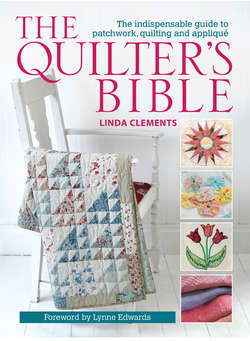Читать книгу The Quilter's Bible - Linda - Страница 66
На сайте Литреса книга снята с продажи.
ОглавлениеScrap Quilts
Scrap quilts are traditionally made up of small pieces and offcuts of fabric, pieced together in a chosen arrangement. These quilts often have a colourful quality but scrap selection can also be within a specific colour range. Some people define a scrap quilt as one where little or no new fabric is bought for the project. String patchwork (see String Patchwork) is often described as scrap work. Making a scrap quilt is a really easy way to begin quiltmaking, but even if you are experienced just feeling free to delve into your fabric stash or use up small remnants is a relaxing way to work. In addition to providing a great way to use up your excess fabric, scrap quilts can also produce some wonderful results.
Deciding on Colours
For many people a true scrap quilt is one that uses random scraps in random colours – just put two piles together, one of darks and one of lights, and select from each pile in turn as you stitch them together. This casual approach often leads to some interesting effects, with colour combinations that might not otherwise have been discovered.
Selecting the Scraps
The scraps used in this type of quilt can come from many different sources, including those from newly purchased fabrics, offcuts from fabrics used for other projects or pieces cut from old clothing and household textiles. Take care when using old fabrics that you use unworn areas, such as shirt tails. You could also base a scrap quilt around units and blocks previously made and not used, using sashing to unify them all.
Cutting Patches
You can use rotary cutting to obtain a good selection of patches. Try using just fat quarters, stacking four together and cutting one or two strips lengthwise from the stack. Choose another four fat quarters and stack and cut again, and so on. These strips can then be sub-cut into different shapes and should yield a wide variety of colours and prints for you to play with.
Bright, multicoloured scraps are beautifully combined in this scrap quilt by Katharine Guerrier. Only two star blocks were used – Friendship Star and Eight-Point Star – but the scrap arrangement of fabrics creates the illusion of many more blocks.
Choosing a Pattern
The setting for a scrap quilt can be anything you like and perhaps one of the easiest methods is to choose a single block shape, repeated over the whole quilt. One-patch blocks that could be used include squares, rectangles, triangles, diamonds and hexagons. One-patch blocks can form tessellating patterns, where light and dark tones create visually interesting designs – see the diagrams and picture below for some ideas and also. Of course, scrap quilts can also use more formal arrangements, especially those that emphasize light and dark tones – see Common Quilt Settings for ideas.
(left) Half-square triangles paired in a combination of lights, mediums and darks create a pleasing scrap quilt design.
(centre) A repeated block, such as Friendship Star, can create an all-over, tessellating pattern that would be ideal for a scrap quilt.
(right) A scrap quilt can easily be created from a single rectangular pieced block, in whole and half units. These can be recombined to produce an irregular look.
Small units or blocks left over from other projects can be combined in a scrap quilt. If the different scales are a problem, use sashing to bring the units or blocks up to sizes that can then be pieced together.
This scrap quilt made by Jenny Lankester uses light and dark values to telling effect, with squares and a few half-square triangles combined to produce a striking pattern.
